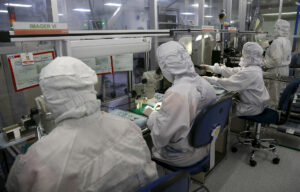FACTORY PRODUCTION grew at the slowest pace in two months in February, signaling weakening demand.
Preliminary results of the Philippine Statistics Authority’s (PSA) latest Monthly Integrated Survey of Selected Industries (MISSI) indicated that manufacturing, as measured by the volume of production index (VoPI), expanded 7.2% year on year in February.
This reading was lower than the revised 11.2% in January and 69.8% growth posted a year earlier. It was also the slowest uptick since December’s 4.6%.
The February result brought average factory output growth to 9.2% for the year to date, much lower than the 40% average in the first two months of 2022.
Domini S. Velasquez, chief economist at China Banking Corp., said in a Viber message that the slower growth in VoPI in February points to a weakening manufacturing sector in the face of waning global demand.
Capital Economics’ emerging Asia economist, Shivaan Tandon, said the February slowdown may be driven by the fall in output for computer, electronics and optical products.
“The global electronics sector is struggling after a pandemic-induced boom. The Philippines has a large electronics sector which makes the economy particularly vulnerable to the ongoing downturn in the sector,” Mr. Tandon said in an e-mail.
The VoPI reading was in line with the manufacturing Purchasing Managers’ Index (PMI), which hit 52.7 in February, slowing from the 53.5 posted a month prior.
The PMI is a leading indicator for future manufacturing activity, as it reflects forward demand expectations in the form of raw material orders for use by factories in a few months’ time. A reading above 50 indicates an expansion in expected manufacturing activity.
According to the statistics agency, three categories were mainly responsible for the slower growth in February, led by food products, slowing to 6.4% from 14% in January.
The contraction in output of computer, electronic and optical products deepened to minus 14.2% from minus 6.9% previously.
Nonmetallic mineral products posted a contraction of 2.7%, a turnaround from the 17.8% rise a month earlier.
The PSA said five other categories out of 22, posted slowdowns in February. These include transport equipment (27.3% form 33.6%), electrical equipment (22.3% from 58.9%), and beverages (22% from 26.7%).
Meanwhile, five categories posted higher growth, led by machinery and equipment (34% from 33.4%), basic metals (30.8% from 15.2%), and printing and reproduction of recorded media (17.4% from 6%).
Four categories declined while four posted deeper contractions compared with January.
February capacity utilization averaged 72.6%, lower than the revised 72.8% in January. The February reading was higher than the 70.1% rposted in February 2022.
Nearly all categories exceeded 50% utilization, the PSA said in its report.
Philippine Chamber of Commerce and Industry President George T. Barcelon expects the manufacturing sector to remain on a growth track in the next few months.
“Now, it’s a question of how to sustain (it)… and one of the concerns is that food prices have been high, affecting consumers,” he told BusinessWorld by phone.
In February, inflation cooled for the first time in six months to 8.6%. It had hit a 14-year high 8.7% in January. In March, inflation eased further to 7.6%.
Mr. Barcelon said the cost of fuel has also gone up, which will likely affect logistics and manufacturing costs.
“In the next few months, we expect factory output to moderate further. The key risk for the sector is higher-than-expected wage hikes, if granted,” Ms. Velasquez said.
Mr. Tandon said he expects manufacturing output growth to slow further.
“The lagged impact of monetary policy tightening at home and abroad is set to weigh heavily on both domestic and external demand. High inflation at home also constitutes another major headwind.”
Mr. Tandon noted that if there is no turnaround in electronics output, the manufacturing sector is set to undergo a weak patch for the coming quarters, and gross domestic product (GDP) growth will slow to 5.5% in 2023. — Abigail Marie P. Yraola
